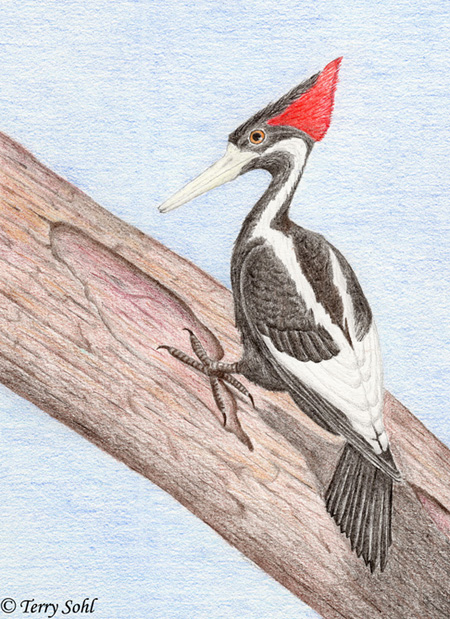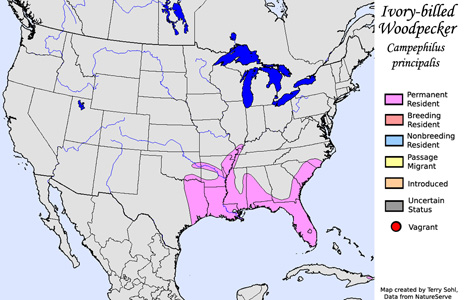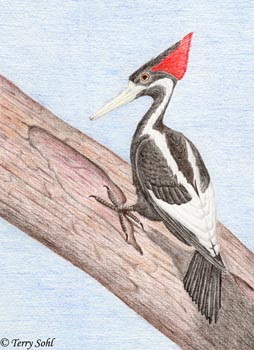Ivory-billed Woodpecker
Campephilus principalis
| Length: 20 inches | Wingspan: 30 inches | Seasonality: Non-resident in South Dakota |
| ID Keys: White secondaries and inner primaries, white coverts un underwing, red crest (male), sturdy ivory-colored bill | ||
 The
Ivory-billed Woodpecker, nicknamed the "Lord God! Bird" for the reaction the
majestic, massive woodpecker often inspired when sighted, is one of the
largest woodpecker species in the world. It is also one of the rarest,
if indeed the species survives. Many in the ornithological community
had assumed the species was extinct, as no accepted sightings had occurred
in the U.S. since the 1940s, and the last accepted sighting of the Cuban
subspecies was in 1987.
The
Ivory-billed Woodpecker, nicknamed the "Lord God! Bird" for the reaction the
majestic, massive woodpecker often inspired when sighted, is one of the
largest woodpecker species in the world. It is also one of the rarest,
if indeed the species survives. Many in the ornithological community
had assumed the species was extinct, as no accepted sightings had occurred
in the U.S. since the 1940s, and the last accepted sighting of the Cuban
subspecies was in 1987.
"Accepted" sighting, however, doesn't mean the bird wasn't reported over the years. In the 1960s in the Big Thicket area of eastern Texas, sightings were reported, including by John Dennis, the man who took the last-known photograph of an Ivory-billed Woodpecker in 1948. Even though he had more experience with the species than nearly any living human being at the time, the Big Thicket sightings were doubted. In 1971, George Lowery, Jr., head of LSU's Museum of Natural Science, brought two instamatic photos of an Ivory-billed Woodpecker to the American Ornithologist Union's (AOU) meeting in 1971. Even though Lowery used to be President of the AOU, he was ridiculed, with people claiming the photos were staged photos of a stuffed bird. In the Pearl River area of Louisiana in 1999, David Kulivan spotted a male and female at close range while hunting. He was doubted. From 1950 to the present day, reports of Ivory-billed Woodpeckers sightings have been made, including by very credible ornithologists, but they have rarely been believed by the majority of the ornithological or birding communities.
In February of 2004, however, Gene Sparling, a kayaker in the Cache River National Wildlife Refuge in Arkansas cautiously reported a sighting. Tim Gallagher from Cornell University and Bobby Harrison from Oakwood College joined a search in the area later in February 2004, and in the nearby White River National Wildlife Refuge, spotted a bird at close range. Extensive searches, led by Cornell, were conducted throughout the next few years, with a number of researchers spotting the bird, and more hearing the tell-tale "double-knocks" or "kent" calls of the species. A admittedly fuzzy video was obtained by David Luneau during the searches. The combined evidence was published as proof of the bird's existance, but skeptics immediately panned the evidence as insufficient. In 2006, Geoffrey Hill of Auburn University published material documenting 14 sightings and dozens of audio recordings of the species in the Florida Panhandle, but no photo was obtained. As with the Cornell published evidence, skeptics denounced the Auburn work as insufficient proof of the bird's existence.
The search for the bird continues to this day. Sightings continue to be made. Sound recordings have purportedly been obtained. Poor-quality photos or video continue to be provided as evidence of the bird's survival. However, no high-quality, documented and verified photograph or video of the species has been obtained since Dennis' photos of the 1940s. Despite sightings by many high-profile and otherwise seemingly trustworthy ornithologists and birders, skeptics continue to doubt the bird's survival.
(Personal note: I strongly believe the bird exists, and that Dennis's
Big Thicket sightings, the George Lowery Jr. photos from 1971, the
Cornell sightings in 2004-2009, and the Auburn sightings in 2005-2006
were actual sightings of the species. Birding, and science, are
curious fields at times, where skepticism, doubt, and yes, egos and
jealousy play more of a role than they should. No photo may exist,
but I find it very hard to ignore the sightings and evidence of so many
good people).
Habitat: Ivory-billed Woodpeckers are documented to have preferred mature, bottomland hardwood forests, as well as Cypress swamps with large mature trees. In the past, birds have been strongly associated with areas of signficant amounts of dead standing timber, especially recently dead timber, as the birds prefer to feed on wood-boring beetle larvae that utilize dead timber. Areas with significant tree death due to storm events (hurricanes, tornados), water level rise, or other tree-mortality event were often observed as holding increased numbers of Ivory-billed Woodpeckers for several years after mortality occurred.
Diet: Ivory-billed Woodpeckers are known for scaling bark to gain access to wood-boring beetle larvae, with large areas of scaled bark often cited as evidence of the birds' presence. However, they also feed on fruits, nuts, and other insects.
Behavior: Foraging often included scaling bark to reveal borings of wood-boring beetle larvae. With their stout, strong bills, Ivory-billed Woodpeckers were well equipped to scale even tightly adhering bark (something the Pileated Woodpecker is less capable of), and drilling deep, conical bore holes to access the beetle larvae. Unlike other woodpeckers which tend to fly in a undulating flight pattern, Ivory-billed Woodpeckers' flight is strong and straight, and has sometimes been referred to as being similar to a duck's flight.
Nesting: Ivory-billed Woodpeckers may mate for life. Nesting occurs in a tree cavity, with 2 to 5 eggs laid. Both parents are thought to incubate the eggs, and raise the young. Size and shape of nesting cavities has been reported to differ from the Pileated Woodpecker, with nesting cavity assessments sometimes being used to infer presence of Ivory-billed Woodpeckers.
Song: Species has a nasal "kent" call that is sometimes referred to as being similar to a toy trumpet. The drumming of the species is a distinctive "double-knock". Recordings of both the kent call and the double-knock drumming have been used to try to document the presence of the species.
Migration: Ivory-billed Woodpeckers are considered permanent residents in their normal range, and are not known to wander widely from that overall range. However, local populations are likely nomadic and shift in response to foraging opportunities. Areas with signficant forest blow-down or tree mortality often resulted in relatively short-term increases in numbers of birds. The species was also said to require very large home territories for feeding. Thus, while not truly migratory, local movements and population shifts likely occur with the species, and may help explain the difficulty in relocating spotted individual birds.
Interactive eBird Map: Click here to access an interactive eBird map of Ivory-billed Woodpecker sightings
Similar Species: Pileated Woodpecker
Conservation Status: See notes above. The species was already considered rare by the 1880s, as vast swaths of southern forests were cleared for timber and to make way for agriculture. The last widely accepted sightings were in the 1940s. Many consider the bird extinct, and if populations survive, they are obviously very minor and in peril.
Further Information: 1) Cornell's All About Birds - Ivory-billed Woodpecker
2) Cornell - Search for the Ivory-billed Woodpecker
3) National Geographic - Ivory-billed Woodpecker
Photo Information: Pencil Drawing - Terry Sohl
| Click below for a higher-resolution map |
 |
| South Dakota Status: Non-resident in South Dakota |
Additional Ivory-billed Woodpecker Images
Click for a higher-resolution version of these images

